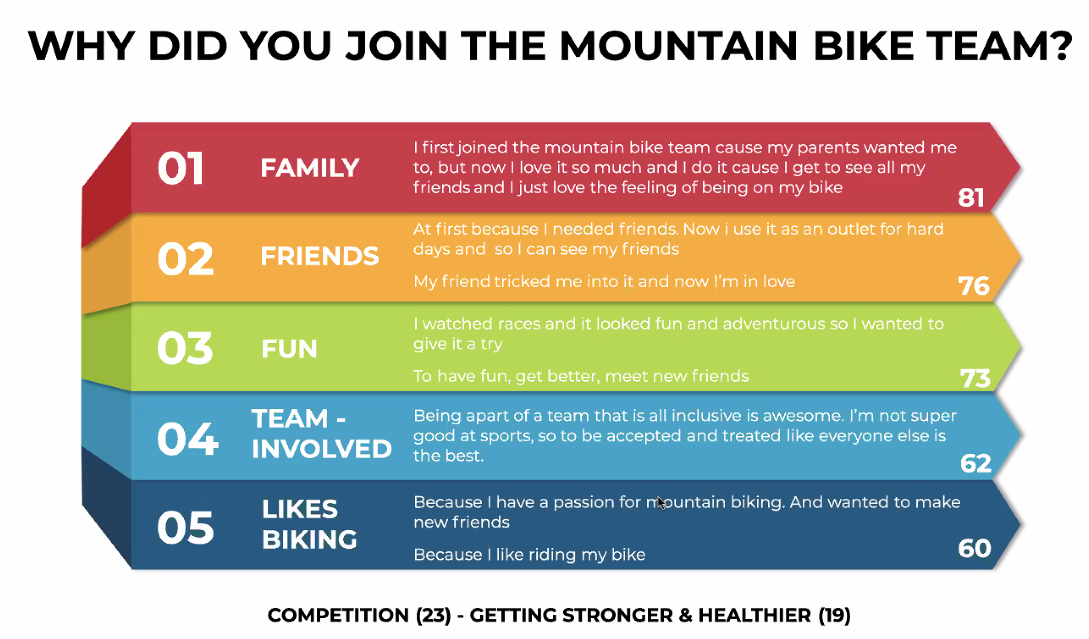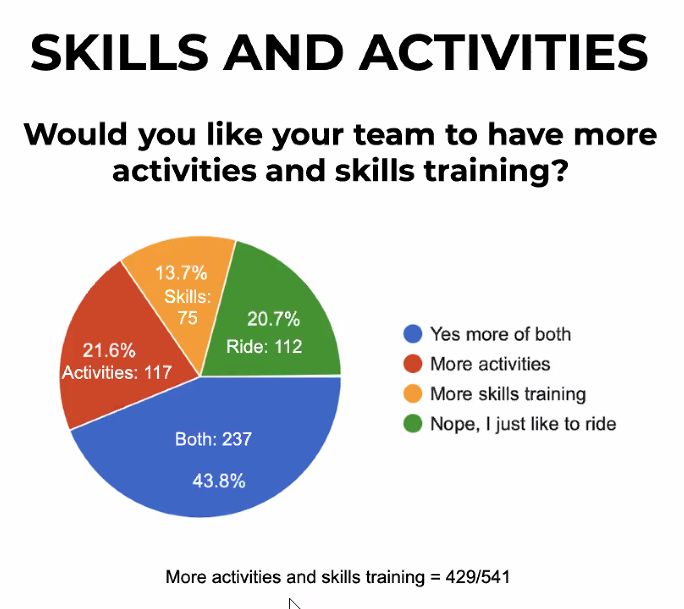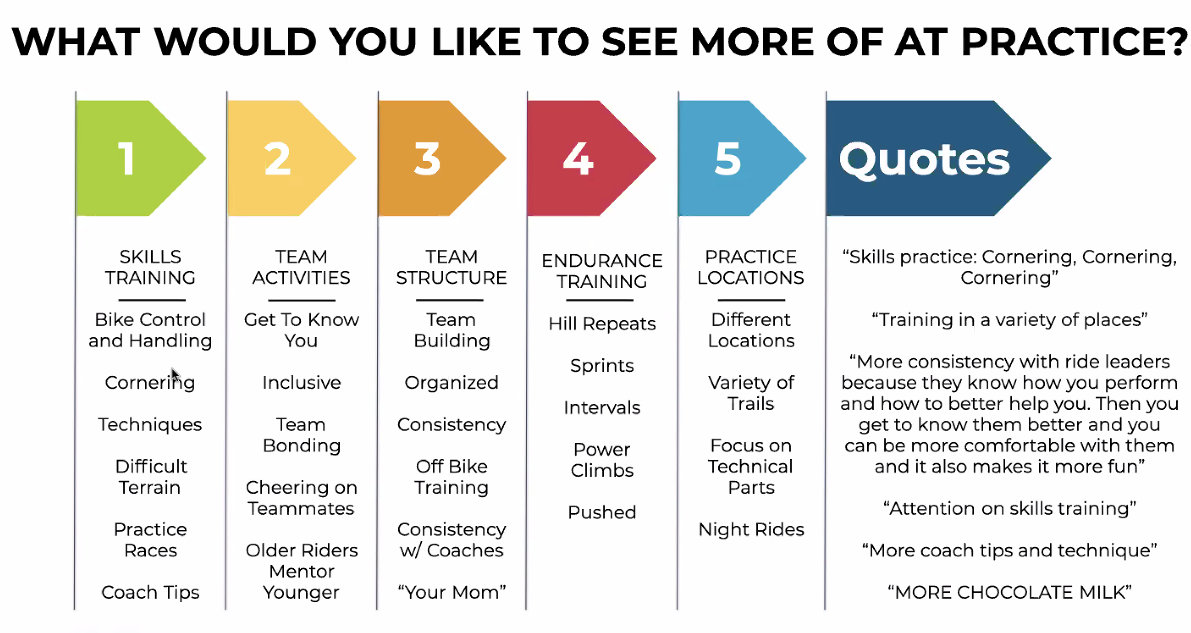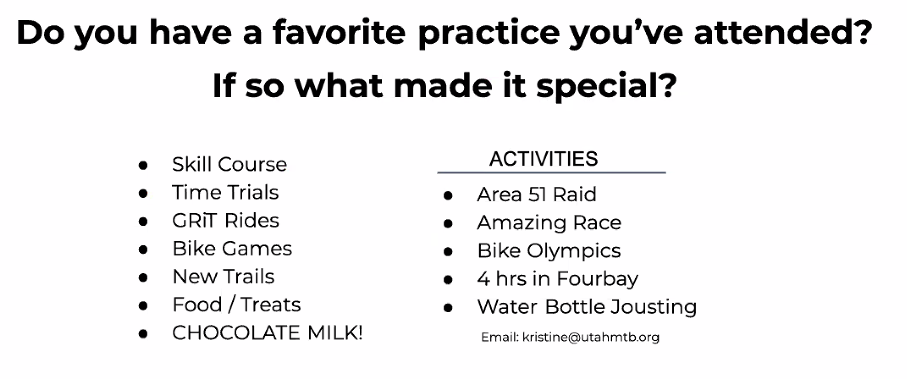This page has information about our team training framework/philosophy.
OUR MISSION
First, it is important to remember what our team mission is. Everything we do is centered around accomplishing our mission. It is why we do this.
Here is our mission:
The Cedar Valley Mountain Bike Team exists to provide as many quality opportunities as possible for local youth to:
Develop as a person through the challenges of hard work and competition.
Build positive, meaningful relationships with peers, coaches, and other leaders
Learn the skills and love of mountain biking
Improve Health and Fitness
Provide great experiences that are fun, challenging, and memorable.
RESEARCH
Our training program has been developed over the last year based on research done, and on mentorship/coaching from some of the best coaches and programs in the country such as Durango Devos. We interviewed 10 top coaches throughout the country, and asked them to share the core foundation of their success and what we should be doing to improve our results and experience. Out of that, came five key findings:
FUN
Everyone we talked to mentioned this first, over everything else. Not only that, but research done confirms this emphasis.
When kids have fun, they ride more, they get better, they get faster. This was the biggest predictor of success for riders and for teams. If kids enjoyed it, they practiced more, worked harder, got faster, and the cycle continued. When kids are not enjoying it, they burn out, quit, and actually find themselves under-performing over time.MORE SKILLS TRAINING
- From beginners to pros, what we’ve discovered is that successful teams and riders spend A LOT more time on skills than we previously thought. This includes both specific drill training, and in-context/on-trail application of that skill.
- Riders who are confident and skilled on their bike are better able to manage their speed through the various terrain and obstacles they encounter on trails and in races. It can be one of the biggest differentiators in a race - especially on technical courses where many riders have to dismount their bikes.
- Teams are practicing skills in drills, games, and on the trails on specific sections and by repeating them many times.
-This is about making kids better mountain bikers first, then fast racers second.GET OFF THE BIKE
- As with any sport or activity that requires coaching, it is critical that we do more actual coaching. Spending all our time going point A to B with a lead coach and trailing coaches often does not allow for us to adequately watch skills, body position, and other factors that we may need to work on. It is important that we spend A LOT more time observing, timing, measuring, and actually coaching.
- More coaching by coaches and more learning by riders!TEAM FOCUS MORE
Team and team culture has been the subject of a lot of research in the past few years, particularly in terms of how it affects performance. Even in a sport where it seems to be more “individual” based, studies have shown that riders who train in isolation or without belonging to a “team”, ultimately burn out and do not reach their full potential. We learned that 1) fast riders make fast riders, and 2) good riders make better riders. What does that mean? It means that we need leaders and chasers to make both the leaders and the chasers better. It was also clear in our interviews that for long term success in a team and with a kid, they need to feel connected to others their age and of their interests. It’s critical that teams develop traditions, habits, and environments that build good cultures.RACE SITUATION SIMULATION
- Teams practice a lot on mimicking things they find in races. From skills situations to length and speed of ride, to specific components of racing like passing, sprinting to finish, starting line, and more.
- It’s important that we create practices that are more similar to our race conditions and race sections.
- It’s a huge part of training for many teams to create competition a lot more often to mimic race day adrenaline, nervousness, and competitive thinking.
LEAGUE STUDENT SURVEY RESULTS
These five factors were recently reinforced by our own League student athlete survey. Check out some of these results:
Notice that most league riders join because of relationships and fun. If we keep that priority in order, then they continue to have their “why” power them to success. If we try to reverse this, and put Biking first, assuming that what got them in doesn’t keep them there, we will lose our culture, they will lose their “why”, and we will not succeed as we should.
Notice that last statement - more activities and skills training was part of 429/541 responses. Most kids know they are largely improvising on the trails with their skills, and many are in need of much more social connection. We are convinced that if we can build those connections better, and improve skills, we will have a HUGE increase in success this year.
Notice #1 and #2 and #3 are all about either skills training or culture factors having to do with fun and/or connections with others.
In the end of everything, most riders are realistic about their futures in Mountain Biking. And fitting with our mission and NICA’s mission, we see that the above responses are not surprising. What they will remember and love the most are great experiences. Their favorite things are related to fun and relationships. We intend to incorporate more fun into how we train, without sacrificing effectiveness of training.
TRAINING PHILOSPHY
Our training philosophy is simple. It should be F.U.N. - this is an acronym for the three elements that make up what we believe will make for the proper environment for success:
FOCUS
- Always have a plan & be organized
- Have a purposed/reason - and communicate it.
- Scales make the best “Jazz” - meaning focus on the fundamentals and repeating them, as it will allow for better long term successUNPLANNED
- Be open to the unplanned, spontaneous
- Use games to allow for this within a structure and with purpose
- The wild river cuts the best canyons!NATURAL
- We work with our strengths
- We know and coach to our “psychology”
- Sincerity is better than authenticity
Bottom line is, we are training kids, not olympians. We are building a lifelong love and skill for mountain biking. We need to build canyons, not canals. The results will follow this.
TRAINING FRAMEWORK
Our framework defines the scope of how we train. It helps us think about how we design, organize and manage training exercises. We believe that if we train within this framework, we will get better at mountain biking, have more fun, and get faster.
CATEGORY | TRAINING AREA | DESCRIPTION | EXAMPLE OF TRAINING |
|---|---|---|---|
PHYSICAL TRAINING | Endurance | Riders need to be able to have a level of fitness to ride their bikes continuously through a race. |
|
Skills | Riders need to have the skills necessary to ride through all the different conditions of the trail/race without needing to stop and without accidents. |
| |
Burst/Speed | Riders need to have the strength and speed necessary to get up steep sections, over obstacles, sprint off the start line, and sprint to the finish line. Burst/Speed training helps develop that extra “Nitro” needed to accelerate or power up and through what is needed. |
| |
MENTAL TRAINING | Knowledge | Riders need to understand the core principles and skills of riding mountain bikes so they can speak the language, understand training, feel more part of the sport, and make better decisions. |
|
Confidence | Riders need to build confidence in their abilities so they can get faster and more skilled |
| |
Toughness | Mountain Biking is hard. We will often face our fears, hard things, disappointments, crashes, and more. Building toughness in our riders will help them overcome these obstacles and get to the next level. |
|
2021 TRAINING GOALS
Maintain and Build on our Culture
- Have fun
- Be inclusive
- Mix the team more (less confined group rides)
- More team rides and activities that are scaled to rider levels'Raise the Average” Philosophy
- Improve all aspects of MTB: skills, speed, conditioning, etc - beak it down into tangible, consumable workouts
- Gear training to help the individual: use assessment more, tracking data and notes on riders
- Deliverable in a group setting with varying levelsBe Well-Prepared
- Know our practice schedule
- Have purpose
- Coaches and ride leaders well-trained
- Designed locations and exercises



